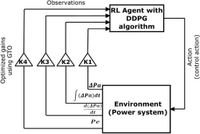As global energy demands continue to rise, ensuring the stability of power systems remains a critical concern. Recent research has unveiled a groundbreaking approach utilizing a Reinforcement Learning (RL)-based Power System Stabilizer (PSS) employing a Deep Deterministic Policy Gradient (DDPG) algorithm to enhance rotor angle stability in various electricity grids.
This novel stabilizer leverages scaled values of a generator’s accelerating power, its derivative, integrated accelerating power, and real power to maintain system stability under disturbances. The unique combination of these inputs helps the system adapt and remain stable when faced with oscillations caused by faults.
The key innovation of this study lies in its optimization of input scaling factors through an innovative Gorilla Troops Optimization (GTO) algorithm, praised for its effective convergence and robustness. By fine-tuning these scaling factors, the RL agent can respond more efficiently to environmental changes, thus improving the overall performance of the PSS.
Simulations conducted on three distinct power systems—a Single Machine connected to an Infinite Bus (SMIB), Kundur’s four-machine system, and the IEEE 39 bus system—demonstrated the superior performance of the proposed PSS compared to traditional systems. The DDPG-based RL agent operated effectively, showcasing marked improvements in transient stability, particularly during long disturbances.
In the tests, the RL PSS proved capable of managing generator speeds and oscillations efficiently, achieving significant reductions in overshoot and settling times. The authors noted that "the proposed PSS performs better than the other PSSs and shows higher transient stability capability than the compared PSS even with long duration faults." This enhanced capability is pivotal for maintaining system integrity in real-world applications.
Key to the effectiveness of the RL-based PSS is its reward mechanism, which incentivizes the agent to minimize the accelerating power. The reward function operates with a sampling frequency of 100 Hz over a 30-second calculation time span, ensuring precise control and quick adjustments to changing system conditions.
Each trial within the simulations revealed the robustness of the proposed stabilizer, even under varied fault conditions, demonstrating its versatility and adaptability. Post-simulation analysis showed that the proposed method requires little retraining when applied to different configurations of power systems, further underlining its practicality for real-world implementation.
Among the significant outcomes, a case study involving the SMIB system displayed the RL PSS adapting to both small disturbances (like voltage reference changes) and severe faults (such as three-phase faults). The results indicated remarkable resilience, making it stand out against the traditional PSS counterparts used in the same tests.
Additionally, the findings from Kundur's four-machine system and the complex IEEE 39 bus system reinforced the adaptable nature of the proposed methodology. Results from these simulations continued to highlight the RL agent's ability to stabilize interarea oscillations effectively.
The flexibility of the proposed PSS is not just tech jargon; it points towards a future where power system operators can efficiently integrate these advanced control methodologies into existing infrastructures. Continuous exploration of this technology may lead to its expansion into domains that incorporate renewable energy sources, ensuring resilience and stability.
In conclusion, the innovative RL-based PSS exhibits a significant leap in rotor angle stability and adaptability. As energy systems evolve, the integration of machine learning techniques and advanced optimization methodologies like GTO will likely play a vital role in the sustainable operation of modern grids, paving the way for more reliable and efficient energy management strategies.

